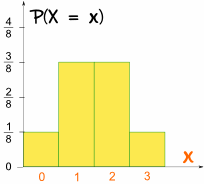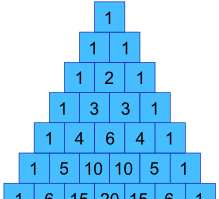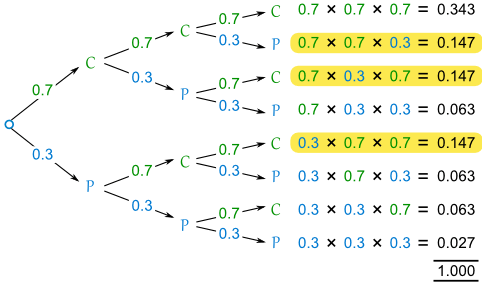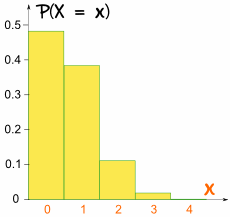The Binomial Distribution
"Bi" means "two" (like a bicycle has two wheels) ...
... so this is about things with two results. |  |
 |
Tossing a Coin:
| |
We say the probability of the coin landing H is ½
And the probability of the coin landing T is ½ | ||
 |
Throwing a Die:
| |
We say the probability of a four is 1/6 (one of the six faces is a four).
And the probability of not four is 5/6 (five of the six faces are not a four) | ||
Let's Toss a Coin!
Toss a fair coin three times ... what is the chance of getting two Heads?
We will use these terms:
- Outcome: the result of three coin tosses
- Event: "Two Heads" out of three coin tosses
Tosing a coin three times could get any one of these outcomes (H is for heads and T for Tails):
| HHH |    | |
| HHT |    | |
| HTH |    | |
| HTT |    | |
| THH |    | |
| THT |    | |
| TTH |    | |
| TTT |    |
Which outcomes do we want?
"Two Heads" could be in any order: "HHT", "THH" and "HTH" all have two Heads (and one Tail).
So 3 of the outcomes produce "Two Heads".
What is the probability of each outcome?
Each outcome is equally likely, and there are 8 of them. So each has a probability of 1/8
So the probability of event "Two Heads" is:
| Number of outcomes we want | Probability of each outcome | ||
| 3 | × | 1/8 | = 3/8 |
Let's Calculate Them All:
The calculations are (P means "Probability of"):
- P(Three Heads) = P(HHH) = 1/8
- P(Two Heads) = P(HHT) + P(HTH) + P(THH) = 1/8 + 1/8 + 1/8 = 3/8
- P(One Head) = P(HTT) + P(THT) + P(TTH) = 1/8 + 1/8 + 1/8 = 3/8
- P(Zero Heads) = P(TTT) = 1/8
We can write this in terms of a Random Variable, X, = "The number of Heads from 3 tosses of a coin":
- P(X = 3) = 1/8
- P(X = 2) = 3/8
- P(X = 1) = 3/8
- P(X = 0) = 1/8
And we can also draw a Bar Graph:

It is symmetrical!
Making a Formula
Now ... what are the chances of 5 heads in 9 tosses ... to list all outcomes (512) would take a long time!
So let's make a formula.
In our previous example, how could we get the values 1, 3, 3 and 1 ?
 |
They are actually in the third row of Pascal’s Triangle ... !
Can we make them using a formula?
|
Sure we can, and here it is:
|  | |
| ||
It is often called "n choose k" and you can read more
about it at Combinations and Permutations.
Note: the "!" means "factorial", for example 4! = 1×2×3×4 = 24
| ||
Let's use it:
Let's use it for a harder question:
Bias!
So far the chances of success or failure have been equally likely.
But what if the coins are biased (land more on one side than another) or choices are not 50/50.
Let's draw a tree diagram:

The "Two Chicken" cases are highlighted.
Notice that the probabilities for "two chickens" all work out to be 0.147, because we are multiplying two 0.7s and one 0.3 in each case.
Can we get the 0.147 from a formula? What we want is "two 0.7s and one 0.3"
- 0.7 is the probability of each choice we want, call it p
- 2 is the number of choices we want, call it k
Probability of "choices we want" (two chickens) is: pk
And
- The probability of the opposite choice is: 1-p
- The total number of choices is: n
- The number of opposite choices is: n-k
Probability of "opposite choices" (one pork) is: (1-p)(n-k)
So all choices together is:
pk(1-p)(n-k)
OK. That was a lot of work for something we knew already, but now we can answer harder questions.
Putting it Together
Now we know how to calculate how many:
| n! |
| k!(n-k)! |
And the probability of each:
pk(1-p)(n-k)
We can multiply them together:
Probability of k out of n ways:
| P(k out of n) = | n! | pk(1-p)(n-k) | |
| k!(n-k)! |
The General Binomial Probability Formula
Important Notes:
- The trials are independent,
- There are only two possible outcomes at each trial,
- The probability of "success" at each trial is constant.
Quincunx
Have a play with the Quincunx (then read Quincunx Explained) to see the Binomial Distribution in action.

Throw the Die
A fair die is thrown four times. Calculate the probabilities of getting:
- 0 Twos
- 1 Two
- 2 Twos
- 3 Twos
- 4 Twos
In this case n=4, p = P(Two) = 1/6
X is the Random Variable ‘Number of Twos from four throws’.
Substitute x = 0 to 4 into the formula:
| P(k out of n) = | n! | pk(1-p)(n-k) |
| k!(n-k)! |
Like this (to 4 decimal places):
- P(X = 0) = (4!/0!4!) × (1/6)0(5/6)4 = 1 × 1 × (5/6)4 = 0.4823
- P(X = 1) = (4!/1!3!) × (1/6)1(5/6)3 = 4 × (1/6) × (5/6)3 = 0.3858
- P(X = 2) = (4!/2!2!) × (1/6)2(5/6)2 = 6 × (1/6)2 × (5/6)2 = 0.1157
- P(X = 3) = (4!/3!1!) × (1/6)3(5/6)1 = 4 × (1/6)3 × (5/6) = 0.0154
- P(X = 4) = (4!/4!0!) × (1/6)4(5/6)0 = 1 × (1/6)4 × 1 = 0.0008
Summary: "for the 4 throws, there is a 48% chance of no twos, 39% chance of 1 two, 12% chance of 2 twos, 1.5% chance of 3 twos, and a tiny 0.08% chance of all throws being a two (but it still could happen!)"
This time the Bar Graph is not symmetrical:

It is not symmetrical!
It is skewed because p is not 0.5

Sports Bikes
Your company makes sports bikes. 90% pass final inspection (and 10% fail and need to be fixed).
First, let's calculate all probabilities.
- n = 4,
- p = P(Pass) = 0.9
X is the Random Variable "Number of passes from four inspections".
Substitute x = 0 to 4 into the formula:
| P(k out of n) = | n! | pk(1-p)(n-k) |
| k!(n-k)! |
Like this:
- P(X = 0) = (4!/0!4!) × 0.900.14 = 1 × 1 × 0.0001 = 0.0001
- P(X = 1) = (4!/1!3!) × 0.910.13 = 4 × 0.9 × 0.001 = 0.0036
- P(X = 2) = (4!/2!2!) × 0.920.12 = 6 × 0.81 × 0.01 = 0.0486
- P(X = 3) = (4!/3!2!) × 0.930.11 = 4 × 0.729 × 0.1 = 0.2916
- P(X = 4) = (4!/4!0!) × 0.940.10 = 1 × 0.6561 × 1 = 0.6561
Summary: "for the 4 next bikes, there is a tiny 0.01% chance of no passes, 0.36% chance of 1 pass, 5% chance of 2 passes, 29% chance of 3 passes, and a whopping 66% chance they all pass the inspection."
Mean, Variance and Standard Deviation
Let's calculate the Mean, Variance and Standard Deviation for the Sports Bike inspections.
There are (relatively) simple formulas for them. They are a little hard to prove, but they do work!
The mean, or "expected value", is:
μ = np
The formula for Variance is:
Variance: σ2 = np(1-p)
And Standard Deviation is the square root of variance:
σ = √(np(1-p))
Note: we could also calculate them manually, by making a table like this:
| X | P(X) | X × P(X) | X2 × P(X) |
| 0 | 0.0001 | 0 | 0 |
| 1 | 0.0036 | 0.0036 | 0.0036 |
| 2 | 0.0486 | 0.0972 | 0.1944 |
| 3 | 0.2916 | 0.8748 | 2.6244 |
| 4 | 0.6561 | 2.6244 | 10.4976 |
| SUM: | 3.6 | 13.32 |
The mean is the Sum of (X × P(X)):
μ = 3.6
The variance is the Sum of (X2 × P(X)) minus Mean2:
Variance: σ2 = 13.32 − 3.62 = 0.36
Standard Deviation is:
σ = √(0.36) = 0.6
And we got the same results as before (yay!)Summary
The General Binomial Probability Formula
| P(k out of n) = | n! | pk(1-p)(n-k) |
| k!(n-k)! |
Mean value of X: μ = np
Variance of X: σ2 = np(1-p)
Standard Deviation of X: σ = √(np(1-p))
Standard Deviation of X: σ = √(np(1-p))

No comments:
Post a Comment